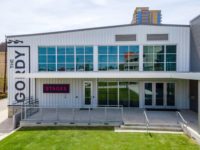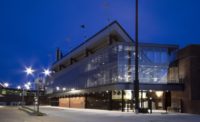Fire safety measures in any enclosed building are critical, but especially so in theaters. The history of deadly blazes in performance venues goes back centuries, and while modern building practices and materials have dramatically reduced the risk of fatalities, theaters still face an uncommon fire threat.
Last year, for example, fires erupted at theaters at Disney World, Hollywood, Branson, and Connecticut. In 2021, three transformers at Jackson College in Michigan caught fire and forced the campus to close. One of the transformers was near a theater in the building. In 2020, a fire at Doris Duke Theater in Becket, Mass. destroyed the building. The theater, part of an entertainment venue called Jacobs Pillow, is an integral part of the tony Berkshire Mountains community. The theater will be rebuilt, and no people died in any of the fires.
Just 2.5 hours east of Becket, the Huntington Theatre in Boston last year completed a $55 million renovation project. One of the issues that required attention were the mechanical systems. The theater opened in 1925 and its systems were inefficient, outdated and energy insensitive. “We were holding it together with chewing gum at the end,’’ managing director Michael Maso said in an interview with The Boston Globe.
An area that drew the focus of the architectural team from Bruner/Cott Architects was smoke vents. The existing vents were positioned vertically and relied on manual operation. They were abandoned in place and replaced with horizontal vents that vastly improve the building’s fire safety.
Smoke Vent Protection
Smoke vents protect property and assist firefighters in bringing a fire under control by removing smoke, heat and gases from a burning building. The vents in place at The Huntington, however, raised a lot of concerns.
“The existing ventilation structure was ineffective, and the theatre relied on manual operation of smoke vents,’’ said Nurit Zuker, an Associate at Bruner/Cott. “The location and condition of the existing ventilation structure on the roof was positioned vertically, but at an angle, which meant it could not be replaced with a modern unit.”
It is not uncommon to find vertical smoke vents above stages in theaters built at the turn of the century (1880-1900’s). A project at a Colorado high school was built with the assistance of the Works Projects Administration (WPA) that also included vertical vents.
“Considered advanced technology over a hundred years ago, the existing non-conforming smoke ventilation system consisted of 24 vertically hinged doors that could be remotely opened 45 feet above the floor,’’ said Vernon Champlin, a Senior Consultant with the fire protection engineering firm Jensen Hughes, who helped the design team with the project at Colorado Springs High School. “The complex system of jute ropes and pulleys allowed the ventilation doors to fall open simultaneously via gravity from a single manual releasing point on the stage.”
Champlin suggested vertical vents that may have been used as horizontal vents were more likely to leak. “In addition, spring loaded mechanical activation had not yet been applied to vents,’’ he said. “It seems that horizontal smoke vents may have become more common in the 1940s with the invention of tempered steel springs and actuators.”
Unusual Solution
Rather than attempt to replace the vertically positioned vents, the team abandoned the existing structure and looked for other options to ventilate the building in case of fire. Architects selected five smoke vents from BILCO, the manufacturer of specialty access products.
“The BILCO smoke vents were specified as a solution as they were ready to install, could be integrated with the fire alarm, and were large enough to ventilate the entire stage appropriately,’’ Zuker said.
The project included four 6-feet x 6-feet double-leaf acoustical smoke vents and a single-leaf smoke vent, 4-feet x 4-feet. The latter is a thermally broken vent and is the first to be used in a commercial application. The thermally broken properties greatly improve energy efficiency.
The thermally broken smoke vent, which was introduced by BILCO in 2022, is part of the theater’s initiatives to reduce energy consumption. The unit is designed with an element of low conductivity integrated between interior and exterior surfaces of the cover and frame to reduce temperature transfer. The thermally broken components also dampen vibration.
“The BILCO smoke vents were specified because they met all the project’s needs,” Zuker said. “The smoke vents are located at the top of the flytower, directly above the theatre stage, and therefore needed to be quiet acoustically. In addition, the units also had the correct size to provide the required ventilation above stage.”
One of a Kind Reno
Beset by a complete shutdown in the wake of a worldwide pandemic and aging infrastructure, the theater closed in the spring of 2020. In October 2022, doors swung open for the first time in nearly 30 months after renovating 75,000 square feet and every facet of the facility.
“The project restores and revitalizes key architectural features of the historic building, highlighting the beauty of the original theater while providing modern comforts and amenities both in public areas and behind the scenes,” Zuker said.
The key word in project is balance. While modernizing the facility, Bruner/Cott Architects and theater management emphasized acknowledgements to the structure’s grand history. The project needed to thread a needle between much-needed improvements while maintaining the historical features that make The Huntington a crown jewel in Boston’s cultural landscape.
“This major renovation addresses sorely needed maintenance and updating of the almost century-old building, providing critical upgrades of all mechanical systems from HVAC to the electrical wiring, making the facility accessible to all, and bringing the building into the 21st century,’’ Zuker said.
The existing building presented a challenge with different floor-to-floor heights in various areas of the building. The theatre box and the production wing did not connect on any floor except the stage.
The plan needed to fix that flaw, but also needed to revitalize key architectural features that highlighted the beauty of the original building while providing modern comforts and amenities in public areas and behind the scenes.
“This balance is achieved by reclaiming the special character of the original façade, drawing attention to it with new signage and architectural lighting, embracing the unique character of the original auditorium, and providing new architecture and interiors that enable modern day social experiences and first-rate physical and technical support,’’ Zuker said.
‘Radical Hospitality’
The other primary objective for the project aimed at improving the patron experience. Everything from seats to restrooms to public spaces were improved as the theater now conveys a concept of “radical hospitality.”
“The design focused on refreshing public spaces, improving circulation and accessibility and elevating the patron experience,’’ Zuker said. “
Visitors enter the building via a new ramp that “ceremoniously bring them to a series of lobbies and to their seats,’’ according to Zuker. Creating an entrance that could be used by all, regardless of physical ability, was important from the very early design stages when the team identified the challenge of different floor-to-floor heights between the various buildings that needed to connect.
The primary public toilet rooms are designed to be all-gender spaces with floor-to-ceiling stalls for maximum privacy. In the renovated theatre, larger, more comfortable seats in a new configuration improve sightlines to the stage. The theater has fewer seats – the new setup includes 739 seats, compared to 890 prior to the renovation – but they are up to 22 inches wide and aisles have been expanded to include up to 22 inches of legroom.
“There’s not a bad seat in the house,’’ Zuker said. “The renovated theatre is now more welcoming, fully operational, and completely accessible and visible. It offers new capacity for creativity, innovation, and outreach and helps elevate the identity and contribution of the Huntington Theatre to Boston’s Avenue of the Arts.”
The project upgraded HVAC and sprinkler systems, electrical wiring and upgrades and modernization of all staff, crew and artist support spaces. The theater includes an automated and programmable fly-rigging system, an elevator that serves all floors for the first time and an entrance that is accessible for all.
Forty-five historic light fixtures were restored throughout the theatre and lobby, and the theatre woodwork was painted “Narragansett Green” – a dark, rich color – while the dome was painted gold to reflect the original design.
Rare Combination
Construction and renovation projects of cultural institutions in communities in which they are based are especially rewarding for any architect. They are the spine of any community, bringing together segments of society that otherwise might not have direct interaction. In any metropolitan matrix, a building that promotes and celebrates unity is important.
The Huntington Theatre project does just that in a building that is now safe, comfortable and accommodating to all. The ability of the architects to stay true to the theater’s history in the process is indeed noteworthy.
“The project blends two areas where our practice thrives – the preservation and renovation of significant historic structures in urban environments and designing for cultural institutions,’’ Zuker said. “We are grateful to the Huntington Theatre Company for selecting us as their partner and trusting us with this significant undertaking.”




